The Standard Missile was originally developed to replace some of the USN's first SAMs, the Terrier and Tartar missiles of the 1950s. From the time it entered service in the late 60s, it was a success, with upgrades giving it more and more capability throughout the 70s and 80s. It was chosen as the primary weapon for Aegis, as well as arming older ships originally built for Terrier or Tartar. Variants were also produced, most notably an anti-radiation missile for use over Vietnam that also gave the USN an interim anti-ship missile capability in the 1970s.
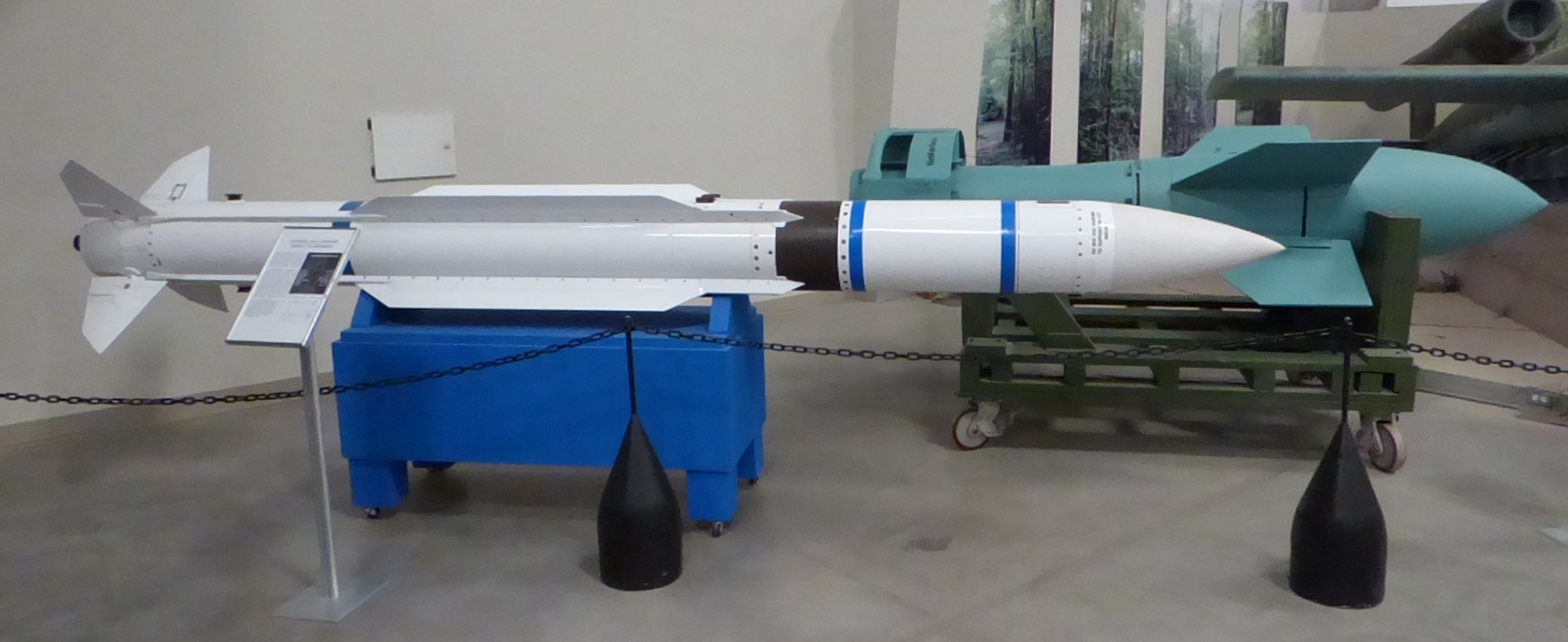
An SM-2MR with a Fritz-X in the background
By the late 1980s, it was becoming increasingly obvious that the Aegis/Standard team would be incredibly effective against high-altitude targets, but less so against sea-skimming weapons. As a result, another version of the SM-2 was built, known as Block III and designed as RIM-66K/L/M (SM-2MR NTU/Aegis Mk 26/Aegis Mk 41) and RIM-67D (SM-2ER NTU). This version had improvements to the seeker and guidance sections to better pick targets out of sea clutter, as well as an improved proximity fuze. It was followed in 1991 by Block IIIA, which introduced an improved warhead and more fuze upgrades, but didn't change the designations. The end of the Cold War saw the NTU ships retired, mostly in the mid-to-late 90s, and the Mk 26 Ticonderogas axed shortly thereafter. This entirely killed off the RIM-67, and saw the RIM-66M as the only survivor of its branch, making things much easier to keep track of. It was the only version to get the Block IIIB upgrade, which saw an IR seeker added to give improved performance in an ECM-heavy environment, as well as probably some limited capability over the horizon, particularly against surface targets. Technically, both Block IIIA and Block IIIB remain the current versions, although there have been a number of upgrades over the years, including another new fuze and software changes to improve maneuverability. I suspect the version numbers have stayed the same as part of a designation engineering strategy.
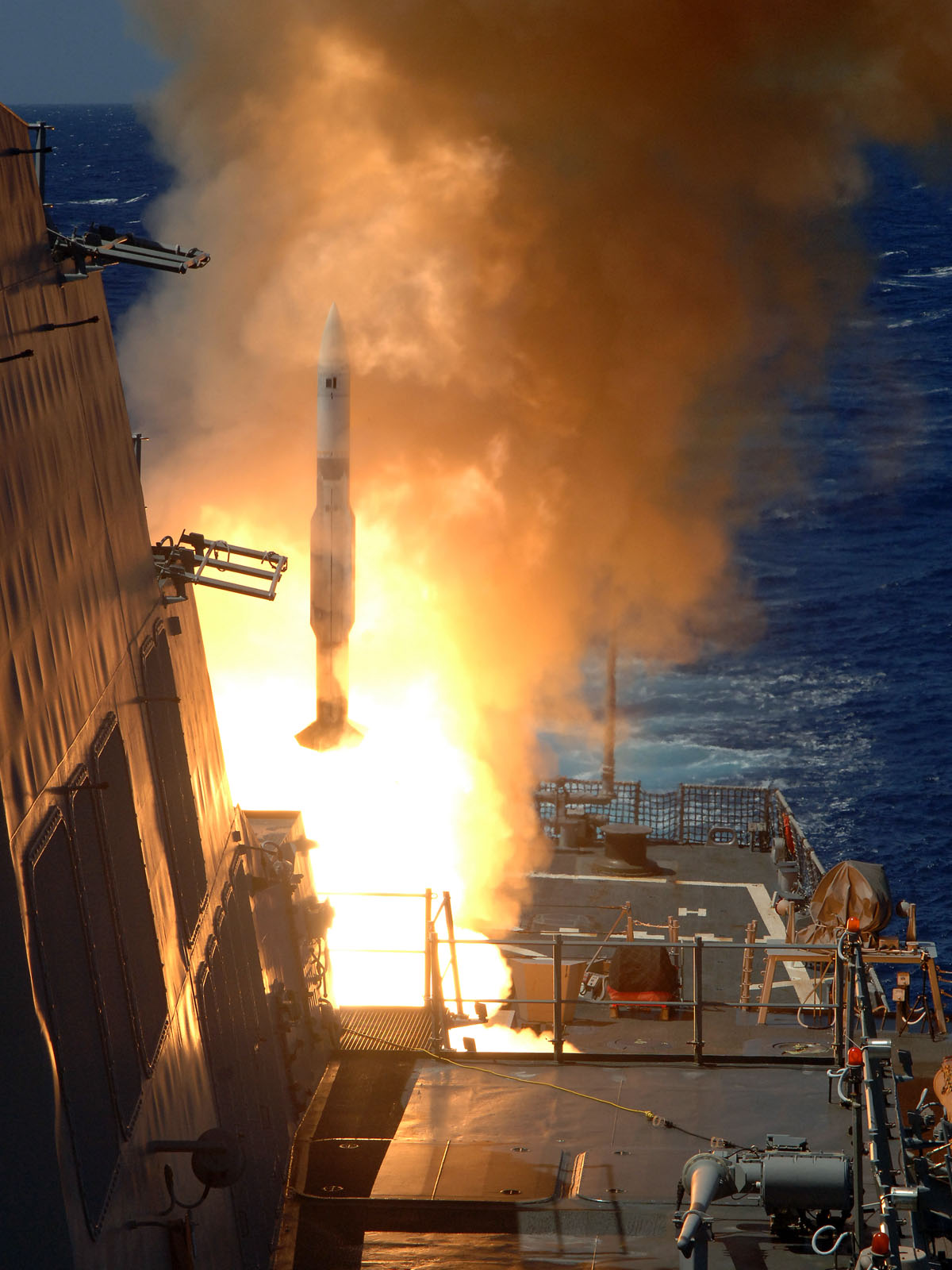
Destroyer O'Kane fires an SM-2MR
None of this is to suggest that work on the Standard family as a whole has stopped since then. The retirement of the Terrier/SM-2ER ships left the fleet bereft of a truly long-range SAM, and improvements in electronics, not to mention the need for a faster missile to use against more difficult targets, prompted the development of a replacement. Announced range was about 130 miles, similar to that for the late SM-2ERs. The SM-2 Block IV would deliver this new missile, which, like the RIM-67, would have a separate booster. The existing booster was far too long for the Mk 41 VLS, and it was replaced by a squat booster that could take advantage of the full diameter of the VLS cells thanks to thrust vectoring, which eliminated the need for fins. The resulting missile, designated RIM-156, also had an improved seeker and guidance system to let it deal with faster and higher targets than ever before when it entered service in the late 90s.
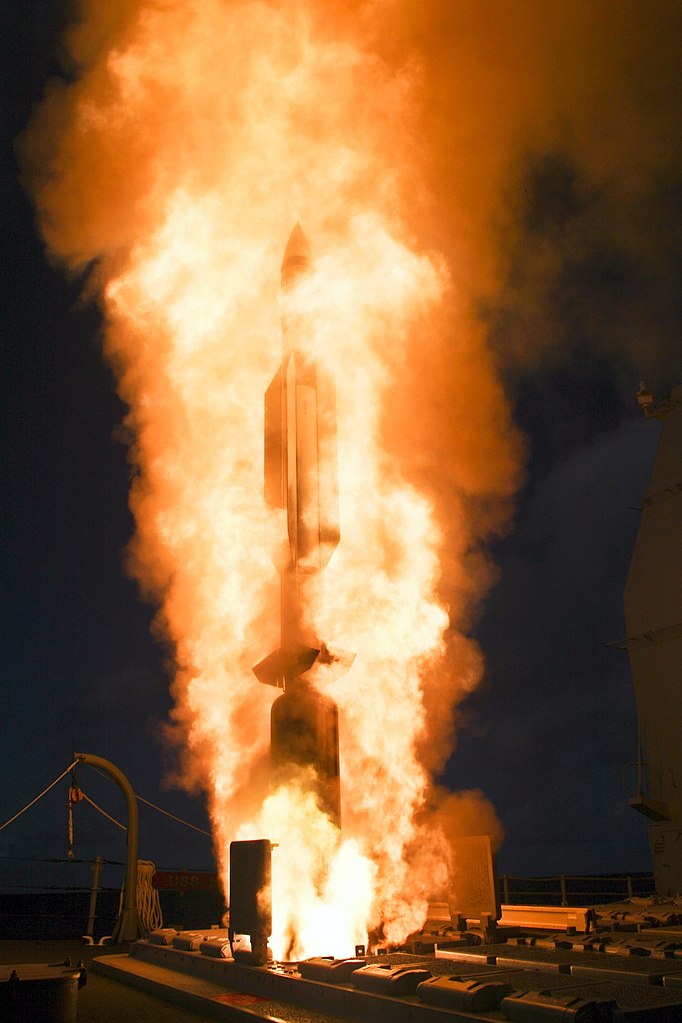
SM-2 Block IV launched from Lake Erie
But work was already underway on a successor, the RIM-156B SM-2ER Block IVA. This weapon was the result of experience in Desert Storm, when Saddam's use of Scuds had caused serious problems for the Coalition. Work swiftly began on Aegis Ballistic Missile Defense (BMD), and the Block IVA would be the chosen interceptor for targets that were within the atmosphere. The big change was obviously to the guidance system, with an improved inertial system and a new seeker including IR capability, although of a different type than used on Block IIIB. A new fuze was also developed to optimize performance against ballistic missile targets, although the new missile should be able to match RIM-156A performance against air targets. Despite several successful test flights, the Block IVA program was axed in 2001, a year or two before it would have entered service, cutting the total RIM-156 buy to only 182 missiles.
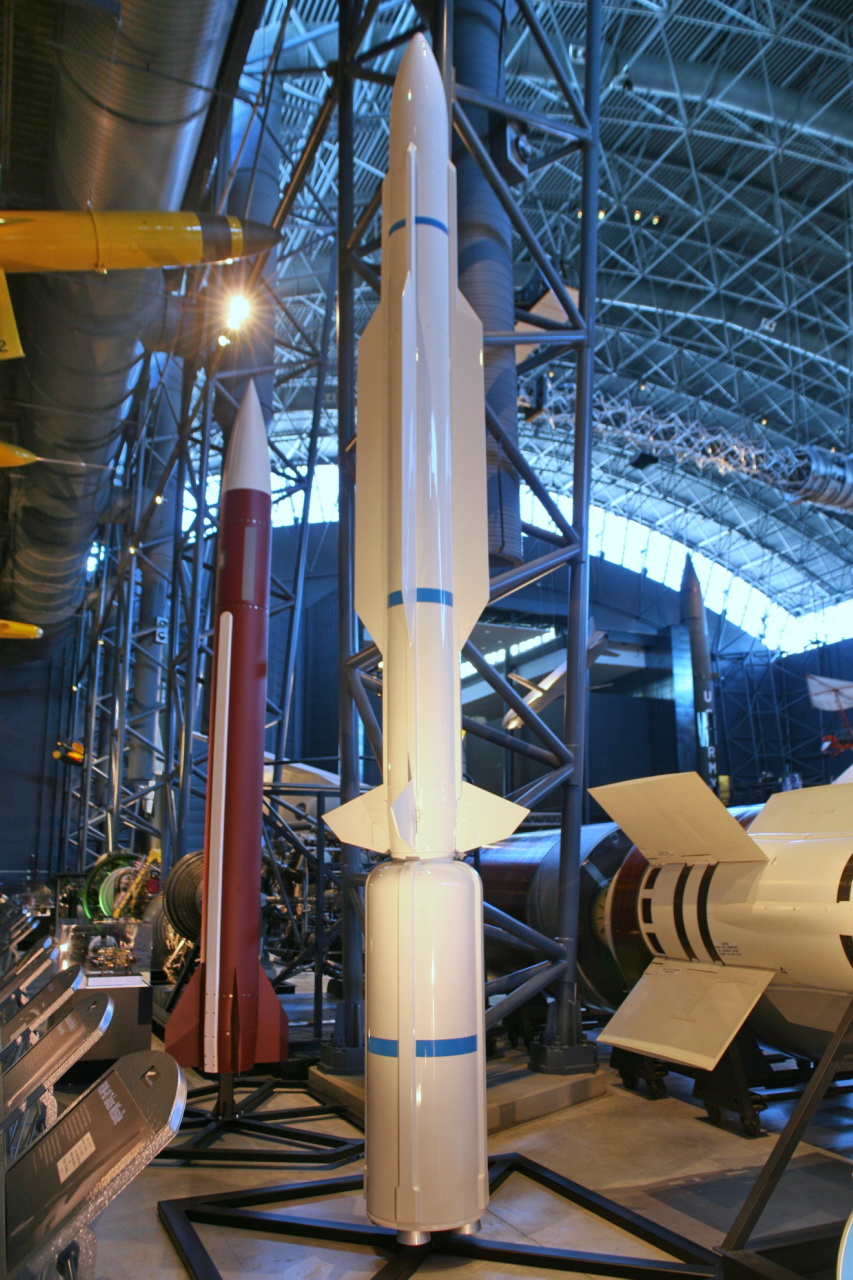
An SM-3 on display
But Block IVA was only one of the weapons that Aegis would wield against ballistic missiles, and it provided the basic outline for the other, the RIM-161 SM-3. The SM-3 was designed for intercept at higher altitudes, up to around 400,000'. This was well before the target had entered the atmosphere, and the missile used the same booster and main motor as the Block IV, mated to a small third stage and an IR-guided kinetic kill vehicle. At the velocities in question, somewhere around 3 km/s for the SM-3 alone,1 simple impact was more than adequate to kill the target, and the projectile places itself on intercept course using a solid-fuel divert system with sufficient accuracy to hit a specific point on the target. SM-3 turned into one of the biggest success stories of the American missile-defense effort, with first fielding of the Block IA in 2006 giving reasonable capability against short-range ballistic missiles. This was underlined in 2008, when a modified missile was launched from cruiser Lake Erie to successfully shoot down failed recon satellite USA-193 to prevent any danger from its hydrazine tank coming down intact.
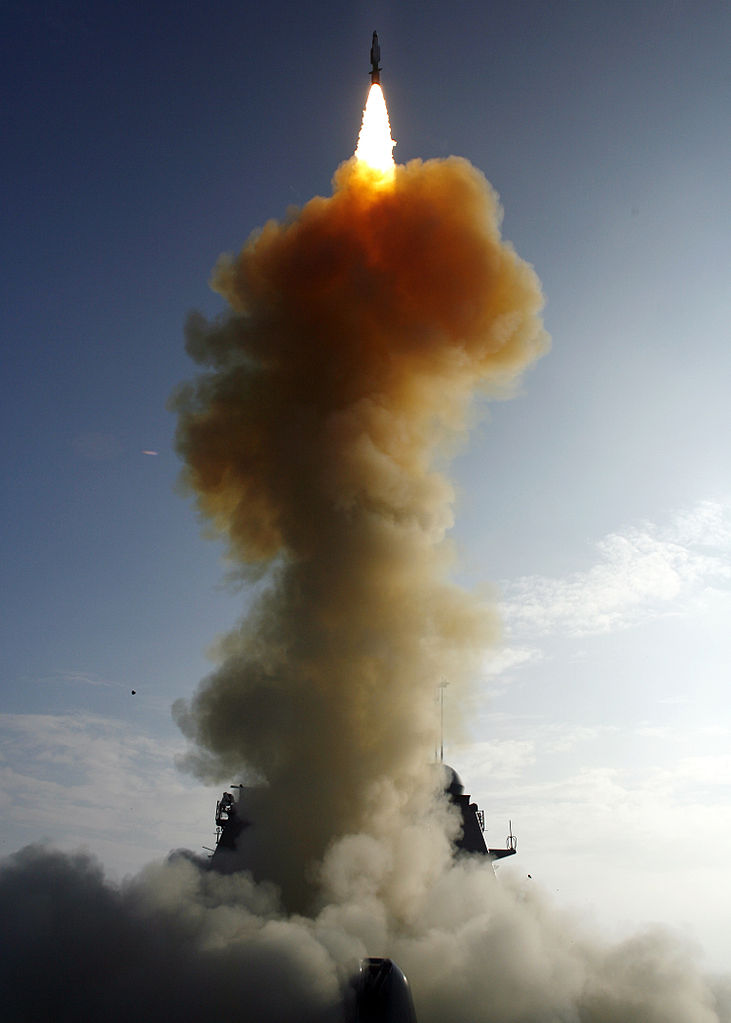
An SM-3 climbs away from Lake Erie to destroy USA-193
SM-3 development has continued over the past 15 years. The Block IB missile had a new 2-color seeker for improved target discrimination and an improved divert system for the kill vehicle. It was bought by both the USN and Japan, which has deployed BMD capability on its Kongo and Atago class destroyers. Today, over 400 SM-3s have been delivered to both nations, and are being used not only at sea but also at an Aegis Ashore site in Romania, essentially a SPY-1 and Mk 41 permanently installed on land. A second site is planned in Poland, while Japan recently cancelled a planned installation due to the risk of boosters landing in populated areas.2 And it was finally proved in combat during the Iranian missile attacks on Israel, when American warships offshore contributed SM-3s to the defense of that country.
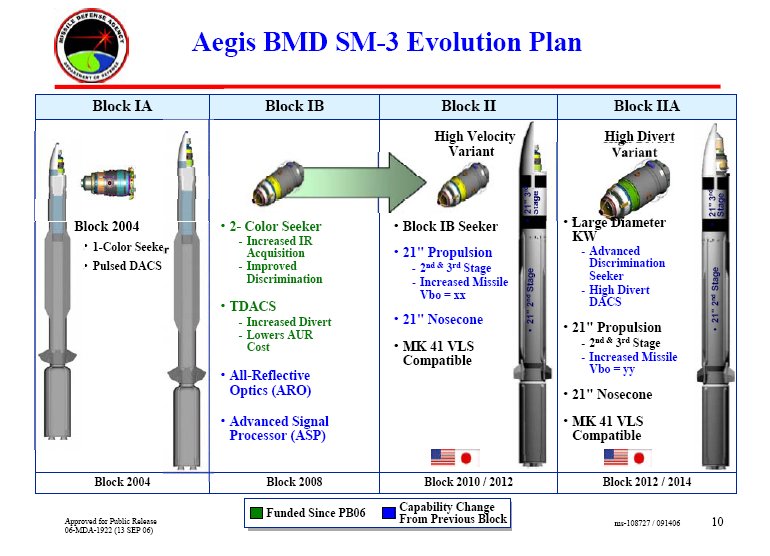
Evolution of the SM-3. Block II was merged into Block IIA at some point after this was made.
Japan provided critical funding for the follow-on SM-3 Block IIA, which sees the first departure for the Standard family from the 13.5" diameter Tartar-derived body that has been its signature. SM-3 Block IIA's upper stage is a full 21" in diameter, giving it a much bigger second and third stage. These are primarily filled with more rocket, resulting in a terminal velocity about 50% higher than the Block I missiles and giving capability against intermediate-range ballistic missiles and even ICBMs, as demonstrated in a November 2020 test. Block IIA also saw improvements to the kill vehicle's sensors and divert system, as well as longer battery life to take advantage of its greater range. It's unclear when this missile will be operational, but the head of the Missile Defense Agency has said that it's ready for production. When it does reach the fleet, SM-3 Block IIA will give the USN truly world-class missile-defense capability, something well worth keeping in mind when the Chinese ballistic missile threat is under discussion.3
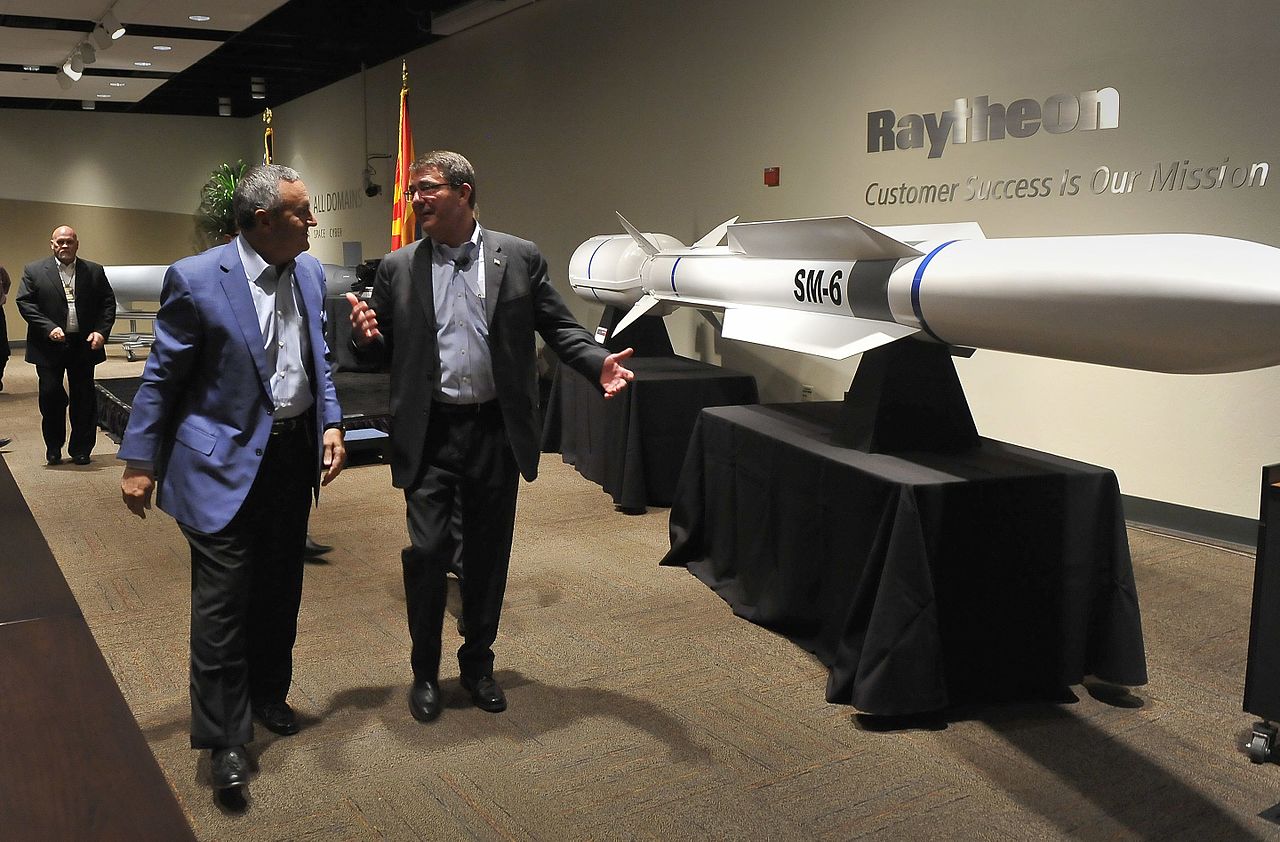
Former Secretary of Defense Ash Carter near a model of the SM-6
Nor does SM-3 have to shoulder the burden of missile defense alone. The cancellation of SM-2ER Block IVA left an obvious gap in the USN's arsenal, and it was to be filled by a new weapon, the RIM-174 SM-6 ERAM (Extended Range Active Missile). The SM-6 is designed as part of the Navy's Cooperative Engagement Capability (CEC), which allows ships to launch using data from other platforms. To give it true over-the-horizon capability, SM-6 integrates the active seeker from the AIM-120 AMRAAM, as well as retaining the semi-active homing capability of its predecessors. The missile merely has to be steered into the seeker's homing basket, removing all illuminator limitations. The official range is stated to be above 200 miles, although given that it uses the same propulsion and airframe as the RIM-156, it's not clear how the range has increased so much.4 SM-6 is capable against all sorts of targets, from low-altitude cruise missiles overland to in-atmosphere ballistic missiles and even hypersonic weapons. It also has GPS guidance, giving it the ability to hit land targets, and was recently selected by the US Army for use in that role, probably with backup anti-air capability. Development is also underway of a Block IB variant, which will replace the legacy 13.5" rocket motor with a full-diameter 21" motor, although why it's not Block II is a mystery. SM-6 also formed the basis for the newest member of the Standard family, the AIM-174B. This was first seen in 2024, and as best we can tell, it's just a slightly modified version of the RIM-174 without a booster. Details are still pretty sparse, with the biggest question being what sort of range is possible given the lack of a booster and higher launch altitude. It appears that this is an effort to give the Super Hornet an ultra-long-range AAM as a counter to the Chinese in a short time, and demonstrates the basic versatility of the Standard design.
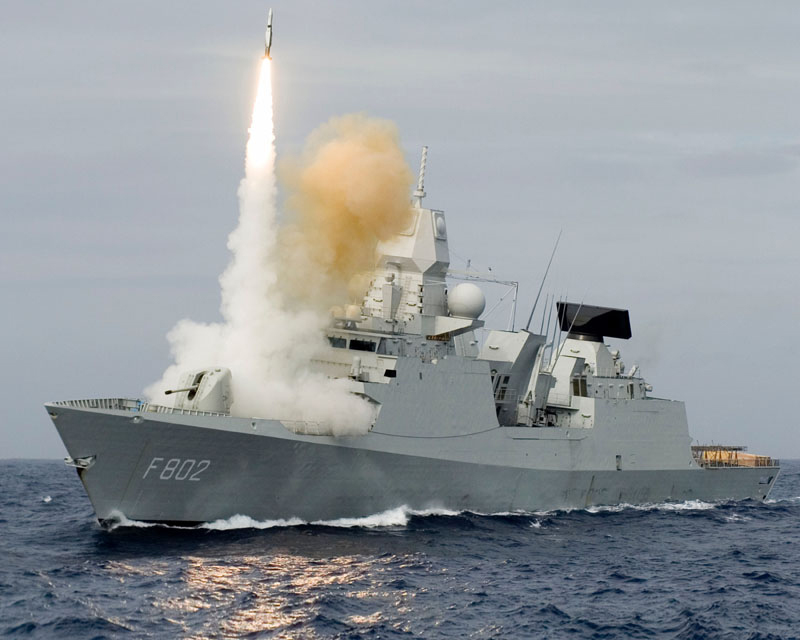
Dutch frigate De Zeven Provincien fires an SM-2MR
Work is also underway to incorporate an active seeker onto the SM-2, which will be designed as Block IIIC. Details are sparse, it seems to have successfully undergone testing and been approved for low-rate production in 2023. But while this is the biggest upgrade to SM-2 recently, it's far from the only one. Foreign customers drove a major innovation in the early 2000s, when the ability to use Interrupted Continuous Wave Illumination was added. This meant that the Germans and Dutch could field Standard on their ships which use APAR, an X-band AESA that is used for both search and missile guidance. This same capability was also used on the Zumwalt class destroyers, which designate using their SPY-3 radars.
But one mystery remains in all of this. What happened to SM-4 and SM-5? SM-4, also known as RGM-165 was a product of the land-attack-crazed 90s, a plan to rebuild old Block III missiles with GPS guidance for medium-range (~150 nm) use against land targets. Land-Attack Standard Missile (LASM) would have given a high-speed option to plug the fire-support gap for the Marine Corps, but it was scrapped in 2003 due to lack of capability against hard or moving targets. SM-5 is variously reported to have been a black program that died before making it into the unclassified world, or a missile with some of the over-the-horizon capabilities of the SM-6 that died on the drawing board.
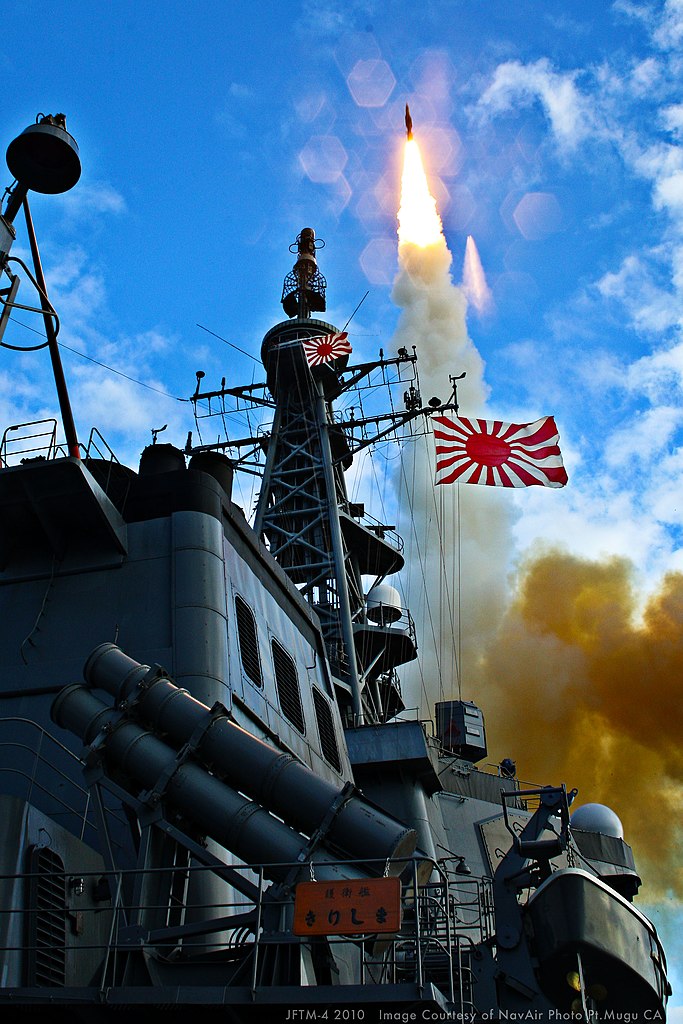
Japanese destroyer Kirishima fires an SM-3 during a test
But through all of this, Standard has been one of the great success stories of defense procurement. For the last half-century, it has formed the backbone of not only the USN's air defenses, but also those of allies including Australia, Germany, Japan, the Netherlands, South Korea and Spain. Thanks to a process of incremental development, it's been adapted to deal with numerous threats, from enemy radars to hypersonic weapons the designers of the original system could barely have imagined it facing. And there's no real prospect of it being replaced any time soon, either. It's very possible that half a century from now, America's warships will still be guarded by Standards.
1 As a rule of thumb, an object traveling at 3 km/s has kinetic energy equal to its weight in TNT. ⇑
2 One wonders why they considered this more of a risk than missile warheads landing on populated areas. ⇑
3 At one point, there was discussion of a Block IIB, with a 27" liquid-fueled upper stage, although this died several years ago, and no follow-on to Block IIA is currently planned. ⇑
4 Command agrees on this, and credits it with 130 miles of range. The only possibility I can think of is that there are significant autopilot improvements which let it fly more efficient trajectories, although I don't know how much that would buy. ⇑

Comments
I feel like clarity would be improved(for dim-bulbs, like myself) if it included a brief description of the SCUD (intermediate-range ...&c...&c...)
Great work as always, boss.
The Italian Navy used both the RIM-66 and RIM-67, even if it has now moved to the Aster 15 and 30.
@ike:
SCUD is the NATO reporting name for a family of missiles based on the Soviet R-11 and R-17, which were themselves inspired by (but substantially improved on) the German V-2. Variants have been built in Iran, Iraq, and North Korea, all with their own designations but generally classified as "SCUDs". The original SCUD entered service in the 1950s, but it's a simple and robust design still in use in what we used to call third-world nations.
It's basically a liquid-fueled ballistic missile about ten meters long, weighing about six tons, and capable of being launched from a cross-country mobile TEL (Transporter, Erector, Launcher). The original version used kerosene fuel, most later models switched to various hydrazine derivatives and a hideously toxic nitric acid blend as the oxidizer. Storable at room temperature, but only the nigh-suicidal would drive cross-country with several tons of the stuff in a thin aluminum missile fuel tank, so usually accompanied by dedicated tanker trucks and so requiring an hour or so of prep time before launch.
A typical Scud can loft a ~1000 kg warhead to ~300 km range, though some versions extended that to as much as 1000 km by either stretching the propellant tanks, reducing the payload, or both. While it is guided, accuracy of the standard version is pretty bad, maybe enough to hit a 1-km circle. The expectation was that in a serious war it would be carrying nuclear or at least chemical warheads, but the Soviets also produced high explosive versions. Those are the ones that have been exported and used around the world. A few of the later models have terminal guidance systems to try and land an HE warhead close enough to destroy a specific target; otherwise the conventional SCUD is a terror weapon similar to the V-2.
About a thousand of them have been used in various wars and insurgencies - it's one of the few ballistic missiles insurgents have a chance of A: getting hold of and B: figuring out how to use. Last time I checked, various factions in the Yemen civil war have been lobbing one off every week or so, at each other or at Saudi Arabia for their meddling.
The SCUD is a troublesome target for missile defense for a couple of reasons. The size and mobility of the launch platform makes it difficult to hunt down and destroy before launch; you wind up destroying lots of ordinary trucks, claiming that you've wiped out the enemy's missile force, and then finding out that the actual SCUD launchers were hidden in caves or warehouses or under camouflage nets.
In flight, it's a bit too high and too fast (Mach 5) for normal surface-to-air missiles to intercept. Dedicated anti-missile or dual-mode systems generally have little trouble getting a "hit", but unlike more modern missiles the standard SCUD doesn't have a separating warhead. So a naive guidance system and/or proximity fuze going for center of mass generally just wrecks the (empty) fuel tanks and leaves the warhead intact. Some of the stretched long-range SCUDs will see the fuel tank break off on its own, in which case the less-smart missiles will see that as the primary target.
Then you claim victory because you saw it blow up real good, and a minute later the warhead falls half a mile away. If you want, you can claim that you at least knocked it off course, but with the accuracy of a SCUD, who knows?
During the 1991 Persian Gulf War, the USAF claimed to have blown up about a hundred Iraqi SCUDs on the ground. Most of those were then launched against Allied forces and/or Israel, whereupon the US and Israeli armies claimed an 80-90% "kill" rate with Patriot missiles. About 80-90% of the missiles then fell in the vicinity of their intended targets, mostly just making loud noises and cratering the desert. One of them did hit a US barracks in Saudi Arabia. As bean notes, this made us take notice and up our missile defense game.
Guidance systems and proximity fuzes can now be set to target the warhead rather than the midpoint of a SCUD-like target, which should improve things dramatically. I don't think any Standards have been fired at SCUDs in anger, but the Saudis claim a ~75% success rate using late-model US Patriot missiles against SCUDs launched by pissed-off Yemeni insurgents, and a late-model Standard should be able to do at least as well.
Of course, now anyone who isn't an insurgent or a third-rate power has better missiles than the SCUD, so who knows.
I wonder if the extra range on SM6 stems from some kind of illuminator limitation with the SARH mode, or maybe some kind of capability to perform ballistic lob shots against non-maneuvering targets. (I'd think that would pose some kind of problem for SARH but might be doable with an active seeker - maybe I'm nuts?)
Will all of these missiles all fit within a standard VLS cell? And will a normal naval ship have the electronics to launch all versions of the Standard missile?
@ike
What John said.
@Emilio
I know that (they were actually the last users of the RIM-67) but made the list of users from those navies which are currently using it, IIRC.
@John
Thanks.
@Jade
That’s possible, and there’s definitely some chance it’s flying a specially-optimized trajectory. I put it in more in the “noticing I’m confused” sense than the “I am actively sure these numbers are wrong” sense.
@Kit
I intend to do a post on VLS at some point before too long, so I didn’t go into detail on that. No, these won’t fit into any VLS. There are three lengths for the Mk 41: self-defense, tactical and strike. Self-defense only takes ESSM, while tactical will handle Standard MR and VLASROC. Strike is required for Tomahawk and the various extended-range Standards. Almost all USN installations are Strike. Can’t say for sure for other nations except Japan (also Strike), although I just noticed that in Lockheed’s current marketing materials, there’s no mention of self-defense length.
As for electronics, usually but not always. There’s often been talk of fitting VLS to ships that don’t have full Standard capability, but outside of ships with self-defense length cells (Nansen and Anzac classes spring to mind) the only case I know of where a ship has Mk 41 and can’t fire Standard is the new Type 26, which has 24 Mk 41 cells and is definitely not an air-defense ship. Not sure what they’re going to put there. I suspect Tomahawk, which the RN already operates from its submarines, but that’s not confirmed.
(Of course, to make things more complicated, the Canadian variant, numerically the largest version, does look like it will have Standard capability from those cells.)
@John
Thank you for the detailed explanation.
I love how the primitive single-stage design gives it noticeable anti-interception protection.
Russia has the SA-N-7 and SA-N-12 missile systems, which look an awful lot like Tartar or Standard externally, to the point where I've heard both referred to as "Standardski". Are those actually clones/workalikes/stolen versions, or is that just parallel evolution?
The Israeli cultural memory is that during the Gulf War, when Patriots were launched to intercept a Scud, the Scud warhead survived and blew up a (civilian apartment) building (the inhabitants were in bomb shelters and mostly fine), then the Patriot shrapnel would land and ruin a few other buildings.
With the joke being: An Iraqi Scud is lost in the sky, finds a Patriot, and asks it for directions to Tel Aviv. The Patriot answers "follow me".
@Jade
I don't see a particularly close resemblance, beyond that imposed by the general limits of shipboard operations and packaging. But I'm not an expert on Soviet/Russian SAM development, so it might be more related than I think at first glance.
@bean
The Australian version of the Type 26 - the Hunter class - will apparently be equipped with Standards, like the Canadian version. So it's just the British version that's restricted to short-range missiles only.
Mind you, the Royal Navy has a more robust air-defense capability in its other vessels than either the Australians or Canadians.
@bean
you should put together a flow chart of all this.
The standard really seems to be the missile of Theseus, especially the SM-3. I wonder what sort of break it would take at this point for them to change the name. (Perhaps "photon torpedo" was just a slang term in Star Trek, and the actual designation was something like SM-23SL Block IV.)
"The Missile of Thesus" is the planned subtitle for the history of Standard I plan to write someday. (OK, that's not really true. I don't actually plan to write a history of Standard, and I probably wouldn't subtitle it that because not enough people would get the joke.) But yes, it very much is, and I think that's why it's been so successful. Changing one thing at a time means it can avoid the issues that changing everything at once brings.
Bean, you have it backwards. For academic publishing, the convention is to put the joke in the main title and a sensible description in after colon.
It is even more fun because many database truncate the sub-title, so you just see 'Checkmate' and wonder what the book is about.
@bean
Maybe the self-defence length Mk41 is replaced by the Mk56? They seem to broadly fit the same role.
@ike
USNI isn't exactly an academic publisher.
@Alexander
Could be. Neither the Mk 48 nor the Mk 56 seem quite a 1:1 for the short Mk 41, but I'd guess Lockheed came to the conclusion that they weren't going to sell enough to leave it in their marketing material.
I've heard anecdotally that part of the reason that SM-4 got canned is that SM-2/SM-6 can do a near-enough job anyway in the cases where it would make any sense. Dumber things have actually been done - see bombarding runways with Sea Slug or knocking out land-based radars with Talos - so it seems plausible on its face.
I know SM-6 can do that, given that the Army just bought it in that role. Wouldn't be surprised if it was easy enough to backfit to SM-2 as well.